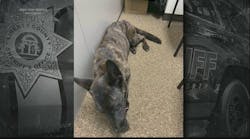Every officer with a decent amount of time on the job knows the unexpected turns an investigation can take. Seeing a major case through to completion often involves giving up on a theory and taking your investigation in a different direction as new information becomes available. In How to Catch A Criminal, we look at the many ways not-so-perfect crimes are solved. This month, a break in a decades old homicide puts detectives on the killer's trail, but the trail turns out to be awfully short.
This article appeared in the January/February issue of OFFICER Magazine. Click Here to subscribe to OFFICER Magazine.
In late 1985, Sherri Rasmussen and her fiancé, John Rutten, married. By February of 1986, the newlyweds were living in a condo in Van Nuys, California. On the morning of February 24, John left for work, but Sherri elected to call in sick. She suffered a back injury at aerobics the day prior and decided to stay home and rest. That evening, when John returned home, he noticed Sherri’s BMW was not outside. He assumed she felt better and decided to go to work after all, but he was quickly proven wrong. A busted sliding glass door was the first sign that something was amiss. John Rutten entered his home and saw a nightmare come to life. Sherri was dead on the floor in a pool of blood, shot three times in the chest. The Los Angeles Police Department was quickly notified of the scene and responded. The scene was processed by detectives, who found Sherri was dressed only in a T-shirt, bathrobe and underwear, evidently not expecting anyone to stop by the condo. In addition to the .38 caliber gunshot wounds, Sherri also suffered injuries to her face, indicating she was struck repeatedly. Furniture had been overturned; there was a bite mark on her left forearm, indicating there had been a desperate struggle and Sherri Rasmussen did not go down without a fight. The scene was evidently a burglary gone awry, given the stolen vehicle. Oddly enough, John and Sherri’s marriage license was also stolen, indicating there may have been a personal motive behind the crime. As detectives chased leads, another crime nearby soon solidified the burglary theory. A few weeks after the murder of Sherri Rasmussen, another Van Nuy’s woman walked into her home and was met by two armed men. They held her at gunpoint before eventually fleeing. The pair were described as short Hispanic males, and they became the prime suspects in the Rasmussen case due to the proximity and similarity of the crimes. Unfortunately, the two Hispanic males were never identified, and the case went cold.
Sherri’s family offered a $10,000 reward for information to bring the killer or killers to justice. Unfortunately, not even the reward money was enough to crack the case. Eventually, the case was briefly reopened in 2005 and evidence was subjected to DNA testing, which wasn’t available at the time of Sherri’s death. Specifically, a DNA swab from the bite mark on Sherri’s forearm. Sadly there was no match to anyone in the DNA database, however, the testing did offer one important detail; The DNA on the bite mark was that of a female. That information was huge because it immediately dispelled the previous theory of the two Hispanic males from the similar home invasion. Sherri Rasmussen was attacked by a woman. This should have pushed the Rasmussen murder to the top of the pile, but for one reason or another it once again fell to the wayside. In 2009, LAPD’s Cold Case Squad was in the process of reviewing old cases to see if any new leads could be dug up. They came across the Rasmussen murder and the 2005 DNA test. When they saw the only suspects were male, but the DNA was female, they began digging through the original Detective’s case notes for any females connected to the victim. There was only one name, and it happened to be that of an ex-girlfriend of John Rutten’s. This ex-girlfriend was also the person Sherri’s father suspected from the beginning.
Nels Rasmussen, Sherri’ father, relayed to detectives at the time of the murder that his daughter had been harassed by a former lover of John’s. He told them his daughter had been threatened at work by an angry woman who insisted if she couldn’t be with John, nobody would. Sherri also complained that this woman stalked her around town prior to the murder. Likely due to the prevailing theory about the male intruders, the scorned ex-lover theory went nowhere at the time. In 2009, however, the female DNA from Sherri’s body set the Cold Case Squad on the trail of Rutten’s ex. In no time at all, they found her and tailed her as she went about her day. After she threw away a coffee cup, the detectives retrieved it and sent it off for testing. It soon came back as a match to the bite mark DNA. In order to ensure the case was airtight, the Cold Case Squad needed the help of another detective, specifically one from LAPD’s Art Theft Squad, right across the hall.
Detective Stephanie Lazarus was a veteran of LAPD and had been working on art thefts, recovering priceless stolen works of art and stamping out one Los Angeles’ most lucrative black markets. In June 2009, Lazarus was approached by a Homicide detective, who informed her a suspect had been arrested and was willing to give up information about a theft she was working on. Lazarus and two other detectives made their way to the jail downstairs, stopping to secure their duty weapons in lockers, as is protocol before entering a jail facility. They entered an interview room, but there was no suspect inside. All three detectives took a seat as a hidden camera rolled, unbeknownst to Lazarus. She was informed the story about the art theft information was untrue. They explained the Cold Case Squad was working a case involving John Rutten and they believed she had a connection with him. Surprised, and likely feeling vulnerable after being disarmed, Stephanie explained that she and Rutten had dated in the past. When asked about John’s wife, Lazarus explained she knew Sherri had been killed, but she didn’t understand why she was being asked about it 23 years later. Lazarus would go on to insist she didn’t remember ever meeting Sherri Rasmussen, and that she never had any sort of confrontation with her. Detective Lazarus appeared shocked that she was being considered a suspect in the case, and she was reassured she was not under arrest and could leave the interview at any time. After over an hour of denying involvement, Stephanie Lazarus puts an end to the interview. As she leaves the room, She is met by additional detectives and a warrant for her arrest. Handcuffed, Lazarus is brought back to the interview room and read her Miranda rights. She declined to make further statements without a lawyer present.
As far as the murder weapon, the evidence is circumstantial, but should be noted. Sherri Rasmussen was shot to death by a .38 caliber handgun, a common caliber for LAPD officers’ backup revolvers in the 1980s. Officers were authorized to carry backup weapons, however, they were not issued by the department and had to be purchased by the officer. Two weeks after the murder, then Officer Stephanie Lazarus, contacted the Santa Monica Police Department to report her car had been broken into while parked at the Santa Monica Pier. She stated a gym bag was stolen, which contained her backup .38 snub nose revolver.
On March 8, 2012, Stephanie Lazarus’ trial concluded with a guilty verdict. She was sentenced to 27 years in prison for the murder of Sherri Rasmussen. The former detective will be eligible for parole in 2039.
About the Author
Brendan Rodela is a Deputy for the Lincoln County (NM) Sheriff’s Office. He holds a degree in Criminal Justice and is a certified instructor with specialized training in Domestic Violence and Interactions with Persons with Mental Impairments.



